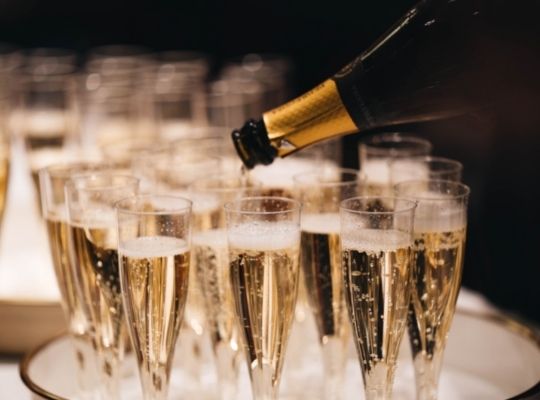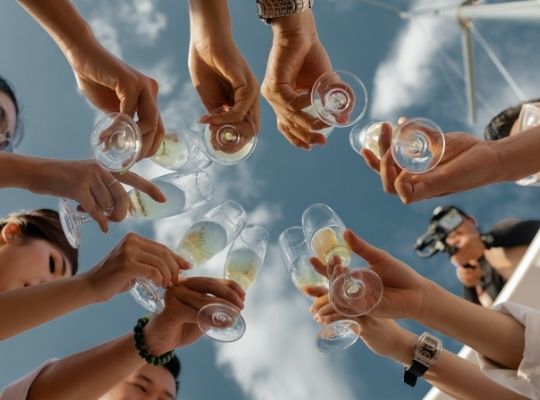Submission Deadline
24 février 2023
Fermeture de l’entrepôt
06 mars 2023
Dates de Jugement
15 mars 2023
Annonce des gagnants
28 mars 2023

Reims, the capital of the Champagne wine region, is only a 1 ½ hour drive east from Paris (less than an hour on the TGV train). Most of the Champagne region lies near the 49th parallel, considered the very northern limit for successful wine growing. As the northernmost wine region of France, the region has a semi-continental climate with generally cool temperatures, particularly in the winter, and humidity that blows in from the West. These factors make obtaining ripe grapes quite challenging here.
Reims was an important Roman city, and the Romans established vineyards around the city and nearby areas. To this day, several of the biggest houses in Reims (Taittinger, Veuve Clicquot, Ruinart, etc.) still have cellars called “crayères” that were originally mines dug by the Romans to extract the beautiful, white chalk typical of the area, used to build the city and its fortifications. Reims has over 200 km of these chalk galleries. Once the rock had been mined, the crayères became the perfect cellars to store wine, as the deep caves maintain a temperature of 11-12°C (51-54°F) with 90-95% humidity.
Until the 17th century, the region produced a light pink still wine that was strongly acidic. When the Kings of France began to use the Reims Cathedral for their coronations, they used the local wines for their festivities, and the wines became quite well known and were drunk at court. The region still produces still white, rosé, and red wines under the appellation “CôteauxChampennois.”

Dans le cadre : Version mousseux du vin
Il fait assez froid en Champagne en hiver, de sorte que la fermentation naturelle qui se déroulait dans les barriques après la récolte (qui nécessite de la chaleur pour continuer), s’est naturellement arrêtée. Avec le réchauffement des températures au printemps, la fermentation recommencerait, de sorte que des bulles de dioxyde de carbone se formeraient dans le vin. Le vin pétillant a été considéré comme un défaut au 17ème siècle lorsque les moines bénédictins comme Dom Pérignon travaillaient sur l’amélioration des vins et des vignobles. Quand ils mettaient le vin en bouteille, la bouteille explosait habituellement, mais quand ils goûtaient les vins dans les bouteilles qui restaient intactes, ils trouvaient que les bulles s’étaient incorporées dans le vin.
Cette version "pétillante" du vin (beaucoup moins pétillante que le champagne moderne) est lentement devenue à la mode, d’autant plus que la cour du roi en a pris connaissance.
Il est clair que, contrairement à la légende, Dom Pérignon n’a PAS inventé le Champagne. Il a cependant apporté une contribution appréciable à la fabrication moderne du champagne en expérimentant la plantation de raisins locaux dans les parcelles les mieux adaptées à eux, et en mélangeant les vins tranquilles pour créer un champagne équilibré.
It wasn’t until the 19th century that champagne winemakers learned to control the fermentation process well enough to consistently make good and marketable champagne. A big part of that was learning to produce a bottle sufficiently thick and stable to contain the pressure of the bubbles (even now a certain number of champagne bottles explode in the cellars). At this time, the famous “méthode champenoise” was developed. The local winemakers were very clever in finding ways to work with the difficult growing conditions they were dealt with. They were able to mitigate the acidity of the grapes in three ways. First, they realized that the bubbles helped mask the acidity of the wine; in fact, acidity became an important part of creating great champagne. Secondly, by keeping reserve wines from the best vintages that they could add into the blend to create more balanced wines in difficult years. And lastly, by adding sugar and reserve wine (and some say perhaps a small amount of brandy) just before corking the wine, thus producing either a brut, extra dry, or sweeter wine. They also gave themselves permission to add red still wine into the blend to make rosé champagne if they wanted to (Champagne is the ONLY region that allows a rosé wine to be made by adding red wine to white wine).
Another great personality of the region, the Veuve (widow) Clicquot, developed the riddling rack and process, which facilitated the slow descent of bitter dead yeast to the neck of the bottle, to be ejected just before bottling. Without the bitterness, it wasn't necessary to add as much sugar, and brut champagne could be made. Many of the other great champagne houses were founded in the 19th century, including Krug, Pommery, and Bollinger.

In Frame: People celebrating with a glass of Champagne
The large houses produce millions of bottles of champagne each year and own a large proportion of the vineyards in the region. But there are also over 5000 small producers, some that only produce 20-30,000 bottles per year using their own vineyards. Many of the small estates produce champagne that is as good as, if not better than, the champagne produced by the large houses (and they’re much less expensive!)
Champagne has four subregions: La Montagne de Reims around that city, which is planted mostly in Pinot Noir; La Vallée de la Marne, along the Marne river which is known for its vineyards of Pinot Meunier; La Côte des Blancs, which is planted primarily in Chardonnay with its beautiful limestone soil; and L’Aube, a more recent vineyard area that is planted mostly in Pinot Noir. Each subregion produces champagne with its own character. La Côte des Blancs is best known for its Blancs des Blancs (white champagne made only of white grapes, so exclusively Chardonnay), considered one of the most elegant, almost ethereal, expressions of champagne. La Montagne de Reims is known for its full-bodied champagnes and the Blanc des Noirs (white champagne made from black, meaning red, grapes).
The vineyards are rated by quality and the price of their grapes, from generic champagne to Premier Cru to Grand Cru. Grand Cru champagne can only be made Pinot Noir and/or Chardonnay, often called the King and Queen of champagne. There are many rules around the production of champagne, including that the grapes can only be picked by hand in small crates, to keep the weight of the harvest from pressing on the grapes at the bottom and breaking open the skins, allowing the juice to run in contact with the skins (producing a slightly pinkish juice that’s considered a fault). Perhaps the most important rule is an international one: there is now an international accord that allows only sparkling wine made in the Champagne region to be called “champagne”: no other sparkling wine in the world may be called champagne, so the work of all the great personalities that made champagne what it is today is protected forever.
© Lauriann Greene, 2021